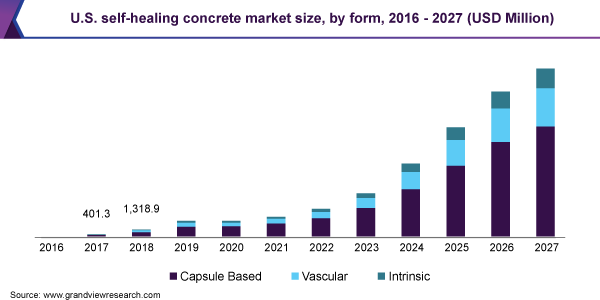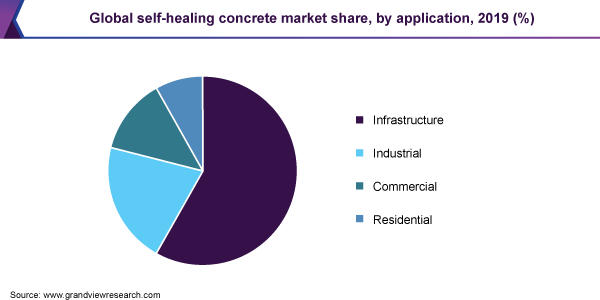- Home
- »
- Advanced Interior Materials
- »
-
Self-healing Concrete Market Size & Share Report, 2020-2027GVR Report cover
![Self-healing Concrete Market Size, Share & Trends Report]()
Self-healing Concrete Market Size, Share & Trends Analysis Report By Form (Intrinsic, Capsule Based, Vascular), By Application (Residential, Industrial, Commercial, Infrastructure), By Region, And Segment Forecasts, 2020 - 2027
- Report ID: GVR-4-68039-094-2
- Number of Report Pages: 100
- Format: PDF, Horizon Databook
- Historical Range: 2016 - 2018
- Forecast Period: 2020 - 2027
- Industry: Advanced Materials
Report Overview
The global self-healing concrete market size was valued at USD 24.60 billion in 2019 and is expected to expand at a compound annual growth rate (CAGR) of 37.0% from 2020 to 2027. Rising demand for reliable and durable constructions, such as infrastructure, commercial, industrial, and residential, is expected to drive the demand for self-healing concrete over the forecast period. Ascending growth of the construction industry across the globe, coupled with a rise in demand for reduction in the structural maintenance of the buildings, is further likely to support the market growth. However, the COVID-19 pandemic across the globe has impacted the construction output in the second quarter of 2020, which has hampered the market for the product.

In the U.S., the market for self-healing concrete is anticipated to expand at a CAGR of 34.9% in terms of revenue from 2020 to 2027. The construction industry in the U.S. is anticipated to witness significant growth over the forecast period on account of growing inclination towards industrial development and rising demand for commercial constructions in the country.
The market is expected to expand at a high growth rate in the upcoming period owing to the rise in demand for less maintenance of building and infrastructure. To enhance the lifespan of buildings and structures, self-healing concrete offers feasible solutions, thereby gaining traction in the construction market.
Traditional concrete and its related substances are subject to crack over a period of time, resulting in increased tension on walls and beams. To support the crack repairs and reduce maintenance of the buildings, self-healing concrete is used in the construction process. This specialized concrete produces limestone with the help of bacteria present in the concrete substances.
The rise in demand for eco-friendly and sustainable constructions with high endurance is expected to drive the demand for self-healing concrete. However, nowadays, the proportion of non-hardening cement in the construction process is less, along with growing trends of fast construction. Moreover, unskilled labor is scaling the proportion of natural cracks in walls and columns of buildings. Thus, the service and repair activities of the construction are likely to ascend the demand for self-healing concrete over the forecast period.
Form Insights
In 2019, the vascular form of self-healing concrete accounted for the largest revenue share of 62.18% and is expected to witness the highest growth over the forecast period. This form is used when a series of tubes filled with concrete healing substances are passed through the concrete structure from the interior to the exterior of the building walls. These tubes need to be placed at anticipated locations wherein the crack is likely to occur, which makes the system non-pervasive.
Capsule-based self-healing concrete is expected to witness notable growth over the forecast period owing to the ease of convenience the technique offers for large-scale usage. These substances when poured into the gaps react with air or another embedded concrete matrix and create hardened substances that fill gaps in walls and other building components.
Bacteria-based capsules for self-healing are preferred in the market as these have an extended lifespan and can stay active for over 100 years. Whereas the chemical-based capsules may lose healing capabilities over a period of time and thus are less popular in self-healing applications. Cylindrical shaped capsules take up larger areas and can be built at higher lengths, and thus have a better healing mechanism than spherical shaped capsules.
Vascular-based healing technology is used when a series of tubes filled with concrete healing substances are passed through the concrete structure from the interior to the exterior of the building walls. This technology can be implemented through a single or multi-channel approach depending on factors, including building shape, concrete strength, and a number of healing agents.
Application Insights
The infrastructure application segment held the largest share of 58.3% in 2019 in terms of revenue and is likely to witness significant growth over the forecast period. The rising initiatives by the construction companies to commercialize the product for the durability of infrastructure by collaborating with the product development companies are expected to ascend the product demand.
Industrial construction needs to withstand harsh mechanical impacts owing to heavy-duty operations, including carriage of vehicles, operating heavy machinery, and heat treatments that require rigid surfaces with durability. Hence, self-healing concrete is expected to gain traction in industrial construction since these structures need strong resistance to various physical and chemical factors to comply with the technological requirements for a safe and convenient surface to carry out industrial operations.

The use of self-healing concrete in residential and commercial buildings is expected to help reduce the permeability of the construction and manage cracks. Foundations, grade slabs, floorings, basements, and walls are the key applications areas where reinforcement of the concrete is required to increase the lifespan of these structures.
A rise in the number of construction activities for office buildings, institutions, healthcare centers, education centers, hotels, restaurants, and other commercial complexes is anticipated to provide growth prospects for the market. Furthermore, the adoption of technical changes in building practices for enhancing the durability of the structures is likely to support the market growth on a positive note.
Regional Insights
Europe dominated the global market in 2019 with a revenue share of more than 53.0% and is expected to witness significant growth in the projected time. In Europe, positive indications in private and public debt are fueling the growth of the construction industry, which is expected to favorably contribute to market growth.
Western European countries including Germany contribute significantly to the growth of the global construction industry. The various projects undertaken by the government and initiatives put forth have propelled the market growth. The country during pandemic has taken superior supportive measures for its economy, which resulted in the positive growth of the country as compared to the U.K. and France.
North America is one of the mature markets for concrete products. The region has a significant presence of multinational companies dealing with concrete products and related raw materials. Product innovation and investment in R&D capabilities by these companies have contributed magnificently to the overall growth of the market.
The growth of the construction industry in the Asia Pacific is attributed to the rising needs of a growing population. Furthermore, the growing economic prominence of Southeast Asian countries, China, India, and other countries owing to the presence of a large consumer base, low labor cost, abundant resources, and increasing per capita income among the middle class in countries, like China and India, is anticipated to fuel the growth of the construction sector. This is indirectly expected to drive the construction materials market, thus fueling the growth of the market.
Key Companies & Market Share Insights
The market is moderately competitive on account of the limited presence of concrete manufacturers and less awareness about the product in the market. However, the competitive environment for materials used in self-healing concrete is moderately high as the procurement practices and material prices are dynamic. Raw material suppliers, concrete manufacturers, healing agent suppliers, and end-users are the different entities of the market. Key players are engaged in the manufacturing and supply of healing agents for concrete products. Some prominent players in the global self-healing concrete market include:
-
Basilisk
-
PENETRON
-
Kryton
-
Xypex Chemical Corporation
-
Sika AG
-
BASF SE
-
Hycrete, Inc.
-
Cemex
-
Oscrete
-
GCP Applied Technologies
-
RPM International
Self-healing Concrete Market Report Scope
Report Attribute
Details
Market size value in 2020
USD 25.83 billion
Revenue forecast in 2027
USD 305.38 billion
Growth Rate
CAGR of 37.0% from 2020 to 2027
Market demand in 2020
338,000.0 cubic meters
Volume forecast in 2027
6,672,347.1 cubic meters
Growth Rate
CAGR of 50.0% from 2020 to 2027
Base year for estimation
2019
Historical data
2016 - 2018
Forecast period
2020 - 2027
Quantitative units
Volume in cubic meters, revenue in USD million/billion, and CAGR from 2020 to 2027
Report coverage
Volume forecast, revenue forecast, company ranking, competitive landscape, growth factors, and trends
Segments covered
Form, application, region
Regional scope
North America; Europe; Asia Pacific; Rest of World
Country scope
The U.S.; Canada; Mexico; The U.K.; Germany; France; China; India; Japan; Brazil
Key companies profiled
Basilisk; PENETRON; Kryton; Xypex Chemical Corporation; Sika AG; BASF SE; Hycrete, Inc.; Cemex; Oscrete; GCP Applied Technologies; RPM International
Customization scope
Free report customization (equivalent up to 8 analysts working days) with purchase. Addition or alteration to country, regional & segment scope.
Pricing and purchase options
Avail customized purchase options to meet your exact research needs. Explore purchase options
Segments Covered in the ReportThis report forecasts volume and revenue growth at the global, regional, and country levels and provides an analysis of the latest industry trends and opportunities in each of the sub-segments from 2016 to 2027. For the purpose of this study, Grand View Research has segmented the global self-healing concrete market report on the basis of form, application, and region:
-
Form Outlook (Volume, Cubic Meters; Revenue, USD Million, 2016 - 2027)
-
Intrinsic
-
Capsule Based
-
Vascular
-
-
Application Outlook (Volume, Cubic Meters; Revenue, USD Million, 2016 - 2027)
-
Residential
-
Industrial
-
Commercial
-
Infrastructure
-
-
Regional Outlook (Volume, Cubic Meters; Revenue, USD Million, 2016 - 2027)
-
North America
-
The U.S.
-
Canada
-
Mexico
-
-
Europe
-
Germany
-
The U.K.
-
France
-
-
Asia Pacific
-
China
-
India
-
Japan
-
-
Rest of World
-
Brazil
-
-
Frequently Asked Questions About This Report
b. The global self-healing concrete was estimated at USD 24.60 billion in 2019 and is expected to reach USD 25.83 billion in 2020.
b. The global self-healing concrete market is expected to grow at a compound annual growth rate of 37.0% from 2020 to 2027 to reach USD 305.38 billion in 2027.
b. Europe dominated the self-healing concrete market with the highest share of 53.4% in 2019. This is attributable to the growing demand for commercial and industrial buildings in the UK, Germany, France, Spain, and Russia.
b. Some key players operating in the self-healing concrete market include Basilisk, PENETRON, Kryton, Xypex Chemical Corporation, Sika AG, BASF SE, Hycrete, Inc. among others.
b. Key factors driving the self-healing concrete market growth include growing demand for reliable and durable construction.
Share this report with your colleague or friend.
![gvr icn]()
NEED A CUSTOM REPORT?
We can customize every report - free of charge - including purchasing stand-alone sections or country-level reports, as well as offer affordable discounts for start-ups & universities. Contact us now
![Certified Icon]()
We are GDPR and CCPA compliant! Your transaction & personal information is safe and secure. For more details, please read our privacy policy.
We are committed towards customer satisfaction, and quality service.
"The quality of research they have done for us has been excellent."





